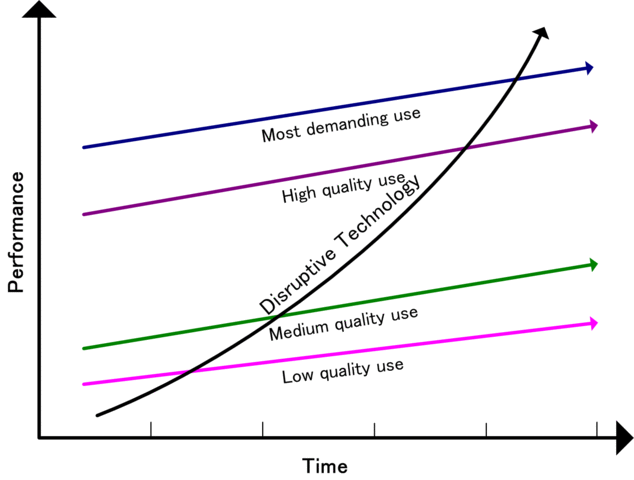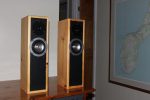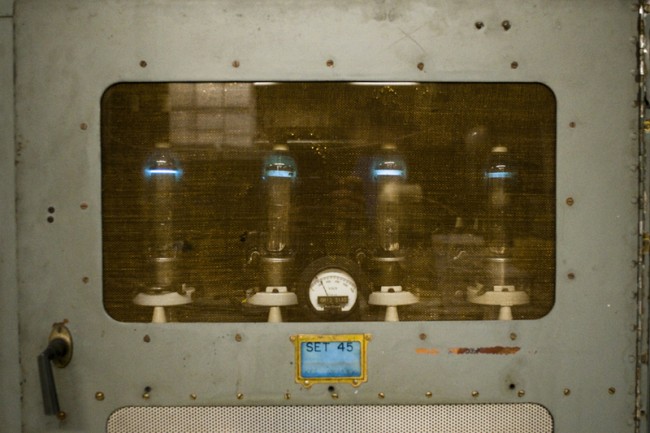Perhaps it is a good time to pose a few questions regarding the future of radio broadcasting and digital radio in particular. For this article, I will assume that everyone understands that digital radio is a type of modulation using data transmitted at high speeds, which is reassembled in the receiver to generate audio for the listener.
- Why is digital radio needed?
- What are the benefits of transitioning to digital radio?
- Who would benefit most?
- Who would benefit the least?
- What are the alternatives to digital radio?
- Why or why not proceed with the transition already started?
To answer the first question, we need to understand the current consumer marketplace and the all-pervasive notion of disruptive (aka destructive) innovation. That is to say, a new technology that builds on existing technology or knowledge, while eventually replacing or destroying its predecessor. Think; horse and buggy vs. automobile, microwave network vs. fiber optic network, wired telephone network vs. cellular phones or film photography vs digital photography. In other words, the older technology becomes obsolete and is abandoned in view of the improvements brought on by innovations.

No one can argue that innovations have not greatly improved our lifestyle and productivity in the last one hundred years. Few would opt to permanently return to an era of no electricity, no electronic communications, and no cars. In order for the destructive innovation argument to succeed, however, the technology in question must be improved in a way that benefits the greater society.
Digital modulation methods have been under development since ATT started using T-carriers to transmit telephone calls over long-distance circuits. Over the years, several different methods were developed including Phase (or Frequency) Shift Keying (PSK), Multiple Phase Shift Keying (QPSK), Quadrature Amplitude Modulation (QAM), and Orthogonal Frequency Division Multiplexing (ODFM).
For various purposes, these digital modulation methods offer distinct advantages over analog modulation methods.
Thus, the proponents of digital radio broadcasting postulate the advantages of transitioning to digital radio are:
- Improved sound quality, often using terms like “CD Quality,” etc
- Improved spectrum efficiency, more broadcasting channels for the same amount of frequency allotted.
- Improved coverage area, less interference, out-of-band noise, etc
- Value-added accessories, such as data services (song title and artist), album art, Electronic Programming Guide, H. 264 video, etc
- Keep up with evolving technology
Thus, the question of why digital radio is needed is answered by listing the possible benefits of such a transition. By the list of benefits above, most consumers would find improvements in digital radio broadcasting as would most broadcasters. In theory, it is not a bad idea.
In the real world, theory, and application are often radically different. Innovation is most often, although not always, driven by a profit motive. Digital radio technology is no different. The proponents of digital radio are attempting to move technology forward while making a profit. There is nothing wrong with that, provided the consumer sees the value in the new technology and embraces it. That is a key part of the current digital radio puzzle which is missing; the consumer.
Unfortunately for digital radio broadcasting, several of the above benefits have not been fully realized in the first iteration of the technology. In several countries, digital radio has taken the form of IBOC via either DRM or HD Radio®. Others choose to do DAB via Eureka 147. In almost every case, the average consumer has not embraced the new technology for several reasons:
- Coincidentally with the rollout of IBOC, the mobile internet has become pervasive through the use of things like smartphones, tablets, and similar devices. Via 3G and 4G mobile networks, consumers can access almost an unlimited number of programming choices from across the world.
- Programming offerings on digital radio differ only slightly from those available on analog radio. Consumers are left with no compelling reason to purchase or install a digital radio.
- The technical advantages of digital radio are not consistent enough or significant enough to make a difference in the listening experience.
- The availability of other competing entertainment mediums such as MP3 players, satellite radio (XM/Sirius), internet streaming, etc.
Many point out that internet-type services require an internet service provider (ISP), mobile data plans, or some other type of paid service. Further; 3G, 4G, and or WiFi services are not universally available. All of that may be true, however, mobile data networks are rolling out far faster than IBOC. Consumers appear to be willing to pay for internet service for a variety of reasons, including mobile listening.
The major flaw of internet technology is the capability of ISPs to cut off service at the request of the government for any reason. There is also the ability to block access to certain websites, countries, search results, or services. There are several bills currently under consideration in Congress to codify this, which is an ominous development. Eventually, one of these bills will make it through and become law, creating some form of censorship on the internet. In light of the potential issues with the internet, free, over-the-air broadcasting is necessary, if not vital, to democracy provided the ownership is dispersed and diverse.
There are distinct advantages to digital radio broadcasting which may be realized with different systems that are developed in the future. It may require a re-think of what it means to be a broadcaster and how to make digital radio broadcasting more like IP-based interactive web streaming, available for free using different frequencies than what is in use currently. The general public has shown, by their lack of interest, that digital radio broadcasting as is being carried out today is not necessary. While digital modulation has been around for quite some time, the politics and bureaucracy involved with creating a digital radio broadcasting service has stunted development, making the technology almost irrelevant.






“Trick or treat? £55m to be spent scaring UK consumers into buying DAB radios”
“So why are these untruths being distributed by Car magazine and the Daily Mail? Because they seem happy to regurgitate propaganda produced by commercial companies who, as a last resort, are reduced to scaring the public into buying DAB radios. UK car audio fitters, UK car radio manufacturers and UK audio retailers would all benefit financially from the public suddenly buying DAB radios en masse. Persuasion has failed as a tactic to grow DAB radio take-up over the last decade … so the strategy now is to scare them into putting their hands in their pockets.”
http://grantgoddardradioblog.blogspot.com/2010/11/trick-or-treat-55m-to-be-spent-scaring.html
This is the only reason that I can see! LOL!
Excellent article. (I linked your blog on my blog, BTW)
What I see is a difficult transition for radio as we need a full digital carrier solution, not this half-as#ed HD thing. In my area terrain really kills the coverage of digital and we cannot upgrade or handle the cost of the extra power at this time. More growth stunting. As for quality, since broadcasters are in the old-style mindset of louder is better, digital doesn’t mean a thing. I continue to have technical issues with HD equipment (Flexstar Exciter), so it is no convenience thing, either. Let’s not talk about time alignment.
I feed we will be pushed into a full digital carrier that can be split into a number of channels. All we have to do is figure out the content and make it consumer friendly. I see large wireless companies like Verizon and AT&T as purchasers of radio station and using that to “penetrate” areas the signal (less transmitters) and relying on the cell network for finishing the bi-direction loop. Consumer on smartphone accesses something, phone/radio, whatever displays and distributes the content.
Just some thoughts. Bottom line is I agree with moving forward, but it must be done either dramatically or in some better way than the HD route.
Thanks, Bill. It is always good to hear from a fellow radio engineer. Have fun at the NAB
Over here DAB+ is gaining ground yet is still a drop in the bucket compared to analogue. Its run in VHF high band around 200Mhz in spectrum all of its own.
The pros:
Extra channels
Less susceptible to electrical interference than AM.
The cons:
Information delay (Sports fans who listen to commentary wile at games hate it and accurate time signaling is not feasible)
Higher receiver power consumption (batteries batteries and more batteries).
Limited coverage.
High receiver cost.
Audible digital artifacts.
Less feasible in emergency information distribution situations.
Rob, that is interesting. At least they set aside a new frequency band for DAB service instead of trying to jam it into the old band, thus degrading existing service.
> More broadcasting channels for the same amount of frequency allotted.
“More broadcasting channels” has not equated to “more broadcasters.” Typically, the same licensees obtain the additional channels, even though in practical effect they are additional spectrum allocations. This is one of the key failings of HD Radio in the U.S.
A few stations lease their unused HD channels to other parties, but not to possible competitors. Thus channel leasing did not introduce facilities-based competition.
The public has tuned out of HD because the additional spectrum was not used to introduce more broadcast diversity — and no, multiple “music formats” does not equate to diversity. Other reasons include appalling neglect of the receiver business by broadcasters as well as retailers; the success of arch-conservative programming that is not enhanced by HD sound; and the industry’s lack of appetite for full all-digital transition.